Sainte-Catherine-de-la-Jacques-Cartier - A peat bog at the centre of innovative research
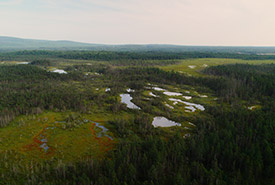
Great Jacques-Cartier Bog, QC (Photo by La Halte Studio)
The Great Jacques-Cartier Bog, a 40-kilometre drive northwest of Quebec City, is full of secrets about a distant past and a sustainable future. Despite the singular bog of its name, this 660-hectare broad complex is home to many wetlands, including different types of peat bogs.
In 2023, the Nature Conservancy of Canada (NCC) announced the acquisition of 200 hectares in this exceptional natural environment. This year, it has also become a site for research that holds promise for the future; the Université du Québec à Montréal (UQAM), an NCC partner, is conducting a major study on carbon capture and climate change at the bog.
A source of knowledge
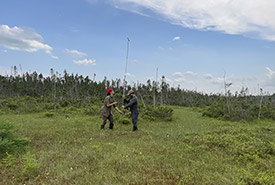
Measuring peat thickness (Photo by Roxanne Comtois, field guide, UQAM)
Peatlands are natural wetland environments where thick layers of organic material accumulate. These deposits, which are saturated with water, only partially decompose and, over the course of thousands of years, transform into peat.
The Great Jacques-Cartier Bog is one of these impressive, and very old, environments.
But that’s not all! This vast wetland is exceptional from another perspective: it is one of the last great peatlands in southern Quebec that is relatively undisturbed by human activity. These characteristics make it the ideal place for the UQAM research project to quantify and map the carbon stored in the peat deposit.
“With the climate emergency upon us, there is increasing interest in carbon capture,” says Gabriel Magnan, a lecturer at UQAM. “And peatlands are now recognized as the most efficient wetlands for the long-term capture of atmospheric carbon.”
Initial promising results
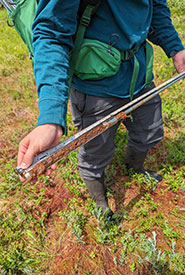
Measuring peat thickness (Photo by Frédérique Turmel, undergraduate intern, UQAM)
To measure the carbon stores contained in the Great Jacques-Cartier Bog, UQAM researchers are starting with the external parts of the peat bog — which are shallower than the centre, and, as a result, contain less carbon — and moving toward the middle. Research is just getting under way, but the UQAM team already has a glimpse of the results.
The analysis of a sample enabled the team to make an initial estimate: according to their calculations, the peat bog may contain 176.4 kilograms of carbon stored per square metre.
This peat cylinder, sampled from one of the wooded bog sections of the Great Jacques-Cartier Bog, is not necessarily representative of the vast complex as a whole; other samples will need to be taken for a more accurate estimate. Nevertheless, the results are promising.
“According to our data and that of other researchers, this value is among the highest for wooded bogs in southern Quebec,” said Reno Bouchard, master’s candidate in biology at UQAM and project participant.
Rethinking land use planning
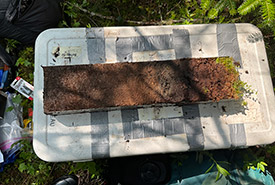
Peat sample (Photo by Roxanne Comtois, field guide, UQAM)
The research project conducted by UQAM goes beyond estimating carbon stores; it aims to explain the very birth and development of peatlands.
Ultimately, the project will provide data that will help us understand peatlands and their role in reducing carbon emissions, and guide land use planning to lessen the effects of climate change — an objective that will be achieved in part through conservation.
“We want to avoid the loss of existing carbon stores, which are very, very important,” says Gabriel. In fact, Quebec’s peatlands contain over half of the province’s land-based carbon stores.
Protecting our future
This project aims to quantify and map, over a three-year period, the carbon stores contained in southern Quebec wetlands. In the meantime, NCC will continue our conservation efforts for major peatlands in Quebec, including the Jacques-Cartier bog.
The research by the UQAM team confirms yet again that the conservation and study of these fascinating environments are worth their weight in gold. It is up to us to act!
Did you know?
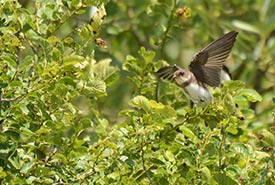
Bank swallow (Photo by Joanne Redwood/iNaturalist)
- Peatlands are feeding and nesting areas for birds, including several species of ducks.
- Several species at risk find refuge in the Great Jacques-Cartier Bog, including southern twayblade (designated as threatened in Quebec), bank swallow (designated as threatened in Canada), as well as smooth green snakeand hoary bat (likely to be designated threatened or vulnerable in Quebec).
- The land newly protected by NCC joins some 100 hectares that we have already contributed to conserving in this area. In total, close to 60 per cent of the peatland is now protected.
- The Lac-à-la-Tortue Bog, in Mauricie, is another large peatland conserved in part by NCC where the UQAM team is working.
Thank you to the financial partners who made this conservation success possible:






The research conducted at the Great Jacques-Cartier Bog received financial support from the Gouvernement du Quebec as part of the 2030 Plan for a Green Economy.

The Great Jacques-Cartier Bog conservation project is part of the Quebec Ecological Corridors Initiative (QECI) launched by the Nature Conservancy of Canada and led by 10 organizations and their many partners. The QECI offers a collective approach to land use planning to accelerate the conservation of natural areas connected by ecological corridors.

Special thanks to Gabriel Magnan, Michelle Garneau, Reno Bouchard and Léonie Perrier from UQAM for sharing their knowledge of this project.




